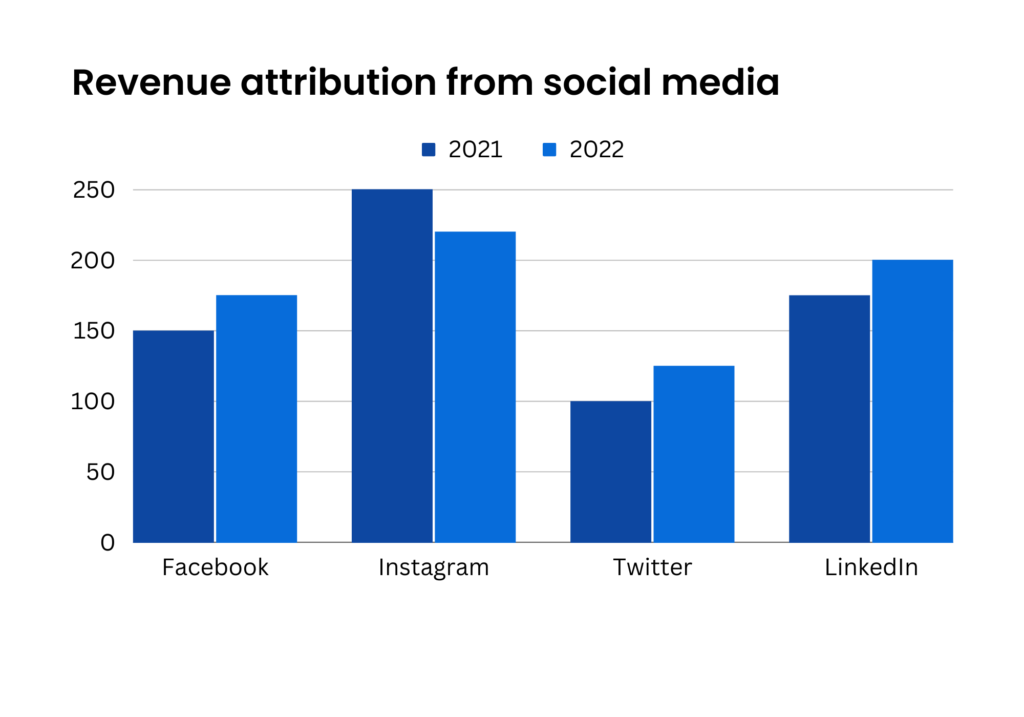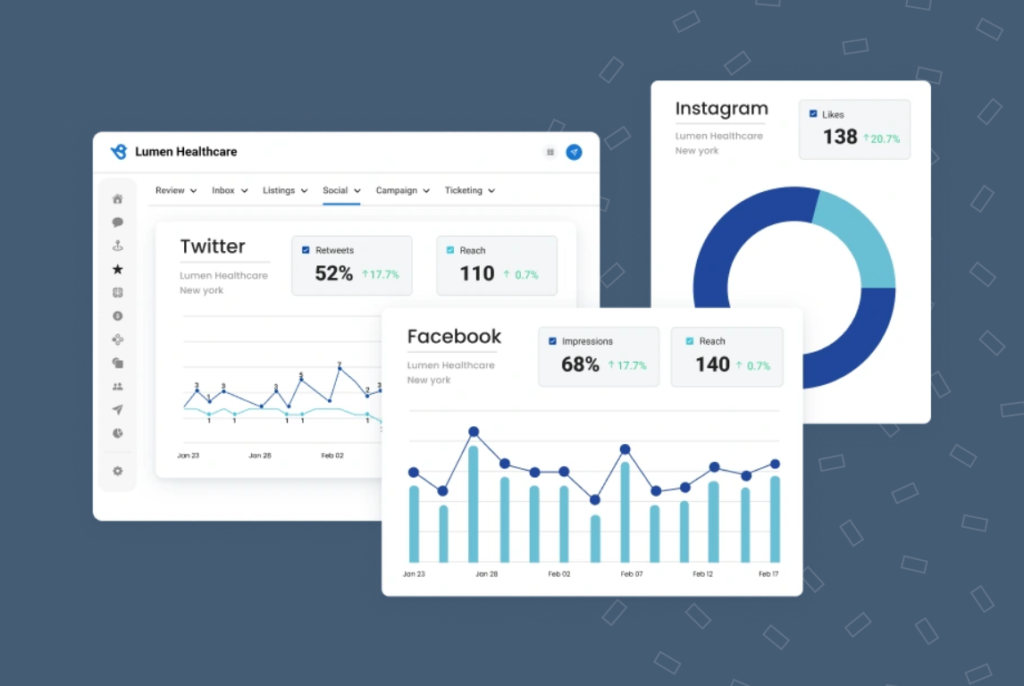Are you excited to run your next marketing campaign and see the results? We completely understand the feeling. But do you know what to look for? Measuring the success of your marketing efforts the right way is crucial. By tracking the right marketing KPIs, you can course-correct, amplify suitable campaigns, and achieve higher goals.
This article tells you the top marketing key performance indicators (KPIs) you must watch out for in your next marketing campaign. Scale new heights by knowing what to look for; let’s get to it.
Table of contents
What are marketing KPIs?
No business can wait until the end of its marketing campaign to see if it went as planned. Also, so many marketing campaigns run continuously in many companies. Measure the efficiency of your campaigns while they are running to see what can be done to improve them.
Marketing key performance indicators or KPIs are metrics you can measure to see if your campaigns are going as per plan to achieve the set goal. They help you estimate actual results and compare them with what you had planned when you began the campaign. Some standard marketing KPI examples are leads, revenue, return on investment, etc.
Staying on top of these metrics helps businesses avoid any surprises at the end of every month.
So what should you look out for? Let’s look at some of the most critical marketing KPIs you must track in 2026.
Top 17 marketing KPIs for every business
Revenue attribution

If your business runs multiple marketing campaigns, this is an important KPI to track for each campaign. Revenue attribution tells you where the money is coming from. With so many paid and organic marketing campaigns, knowing which brings the most leads, revenues, and customers is crucial.
Tracking revenue attribution can help businesses identify the best-performing campaigns they can reinvest in, while dropping the ones that are not performing well.
It is also possible that a lead had more than one touchpoint before becoming a customer. If that is the case for your business, make sure to use a tool that can measure multi-touchpoint revenue attribution.
Start small but do not miss measuring this marketing KPI if you’re just starting out.
Cost per lead
Cost per lead is an important marketing KPI to monitor in 2026. Knowing exactly how much it costs to generate each lead is vital for a business’s financial planning and goal-setting exercise.
The lower the cost per lead, the better, as it means you’re spending less money to achieve your goals. The aim must always be to constantly optimize cost per lead as it helps businesses improve their bottom line.
But how can you track costs per lead?
Well, here’s how:
- Set up tracking goals: Your customer relationship management (CRM) software can be configured to determine how much money it costs to generate a single lead. To do this, establish goals in your CRM software to track your lead source from inception. You can track how many leads are generated across multiple active campaigns to determine the cost per lead.
- Understand your lead generation process: You can capture the accurate cost per lead only if you set all the right touchpoints in your tool. Work with the team to understand how a lead moves through the system to include all the steps in your process and get an accurate estimate.

Sales revenue
Business health is invariably measured by revenue. But measuring your sales revenue accurately can tell you a lot more. You can understand the efficiency of your marketing teams, sales teams, product-market fit, and business growth from this marketing KPI.
Ideally, your sales revenue must exceed your investment to generate that revenue. But this may not be the case if you are just starting. In such stages, measuring sales revenue is all the more important to track your goals and tweak your processes.
How to track sales revenues better?
- Conduct a breakdown. While looking at total sales revenues is essential, you can obtain a more accurate picture of your sales revenues by breaking it down into demographics. Knowing how each demographic performs helps you to gain a deeper perspective of your sales revenues.
- Regular cadence. Regularly assess how your sales revenues are performing in comparison to your losses. While recording a loss is obvious, make it a tendency to periodically measure these losses against your sales revenues at each marketing stage.
Return on Marketing Investment
ROI is a pretty standard marketing KPI that every business tracks. This makes it easier to understand if your marketing efforts contribute to your business goals.
The return on marketing investment is a function of sales growth over the marketing spend. You begin by calculating the sales growth (the difference between sales in this period and the last).
Next, calculate the difference between sales growth and marketing spend. That difference, as a fraction of the marketing spend, is your return on marketing investment. A bigger positive value is always the desired outcome.
ROI = (Sales growth – marketing spend) ÷ Marketing spend
Tracking the return on marketing investment may not give you an accurate picture if you have many active marketing campaigns. You may be spending more on one while the returns might be coming from another.
In such cases, we recommend that larger businesses track their ROI separately for each location, campaign, and business vertical for an accurate picture.
Returns on ad spend
Most enterprises invest exhaustively in ads. While ad investment is a critical component of any digital marketing initiative, knowing the conversion rate of these ads is equally vital in determining business success.
Unlike the returns on investment, which offers a broader view of your marketing and sales efforts, the returns on ad spend (ROAS) gives detailed information on how your ads and campaigns perform. This is one of the most important digital marketing KPIs.
ROAS = Marketing campaigns revenues ÷ Campaign expenditure (or costs)
It’s one of the critical digital marketing KPIs to know how well you’re performing against the competition.
Return on ad spend is usually a significant part of the overall ROI, so if you can optimize this, your overall ROI will be as per your goals.
Customer Acquisition Cost
The customer acquisition cost (CAC) is comparable to the return on marketing investment. However, the customer acquisition cost is more beneficial for companies that use paid marketing channels to build awareness and earn new customers.
To calculate CAC, divide the total marketing and sales costs by the number of new customers acquired.
CAC = Total expenses (Marketing + Sales) / Number of customers acquired with the expense
It’s worth noting that one KPI or metric alone is not enough to paint a good enough picture of the success of marketing efforts by the company. The customer acquisition cost can be compared with the customer lifetime value to determine whether the cost is justifiable.
In fact, part of the acquisition cost may include the cost of a discount or a free trial extended to new customers. If the lifetime value far exceeds this cost, the investment is worth it in the long run.
Customer Lifetime Value
The customer lifetime value (CLV) is the revenue a business expects to make throughout its relationship with a customer. Since businesses spend an incredible amount on acquiring new customers, measuring how much each customer brings in is crucial.
Customer lifetime value is calculated as follows:
CLV = Average Purchase Value * Average Purchase Frequency * Average Customer Lifespan
You can calculate the average purchase value by dividing the total revenue in a period by the total number of purchases. Average purchase frequency is the total number of purchases in a period divided by the number of unique customers. To find the average customer lifespan, sum up the total lifespans of all customers by the number of customers.
The business must focus on increasing one of these three customers to increase lifetime value.
A few ways to do that is
- Improve customer service to increase customer lifespan
- Design and develop products that customers like to purchase frequently
- Improving the importance of your product in customer’s life to increase average purchase value.
Customer lifetime value is significant for subscription-based businesses wherein the average order value may be less, but the overall lifetime value is higher.
Calculating customer lifetime value helps businesses make solid forecasts of revenue. They also form a basis for product improvement and pricing decisions to maximize revenue.
Customer retention rate
As much acquisition is important, retention is cheaper and more substantial in the long term. It’s easier to retain customers than to acquire new ones.
Higher customer retention shows that:
- You are delivering quality products and services
- Your marketing campaigns are working
- Customers value your brand
How to calculate the customer retention rate?
Start by determining the difference the customers have at the end of the calculation period and the number of customers acquired during the period. This value over the number of customers you had at the beginning of the period gives you the retention rate.
For example, for Q1,
Customer retention rate = [(Number of customers at the end of Q1 – Number of customers acquired during Q1) ÷ (Number of customers at the beginning of Q1)] X100
You can improve customer retention by:
- Sending engagement emails
- Collecting customer feedback
- Addressing customer concerns
- Starting a customer loyalty program
Conversion rate
This is one of the most significant marketing KPIs for every business as it directly measures the effectiveness of your marketing campaigns. Conversion rate measures the percentage of people who complete a desired action based on your marketing efforts. It is used across functions and is, in fact, one of the most important email marketing KPIs.
It can be:
- A website visitor that turned into a lead
- A lead that moved from the bottom of the sales funnel to the top of the funnel after a sales call
- A website visitor that became a blog subscriber
- An email subscriber that became an active lead
Calculate the conversion rate by dividing the number of people who completed the set goal by the number of people who interacted.
Closely monitoring the conversion rate can help a business optimize its process and improve faster.
Lead-to-customer ratio
While this may look similar to conversion rate, this marketing KPI solely focuses on understanding the percentage of your leads that eventually become customers. Conversion rate metric measures all intermediate steps as per your requirement. But, for a quick understanding of your marketing and sales processes, look at your lead-to-customer ratio.
Why is lead to customer ratio significant?
It would help if you looked at the bigger picture to achieve your annual goals, and lead to customer ratio gives you that. By setting this goal, you can work backward and understand what the conversion rates at different customer touchpoints should be.
Set this goal right to align your marketing efforts to your business goals.
Marketing qualified leads (MQL)
Leads come from various sources, such as paid marketing efforts, content marketing touchpoints, email marketing, and direct contact. Not every lead is worth pursuing. When you mark a lead as a marketing-qualified lead, you know that the lead is worth going after. It means that the marketing team is confident that this is legitimate.
Ideally, all leads a business generates must fall under MQL, but some are always more urgent than others. You can determine that by:
- Understanding a website visitor’s page visits
- Measuring CTA clicks
- Determining the number of visits or interactions
- Measuring ad engagement metrics
- Checking the customers with most items in cart or wishlists
Organizations must have this extra check to optimize sales resources to identify marketing-qualified leads.
The marketing team can only build a solid bank of MQLs if they are aligned with the sales process, understand consumer behavior, and know the type of leads the business seeks.
Sales qualified leads (SQL)
Every company’s sales and marketing team must work together to achieve the overall goals. Typically, when the sales team agrees with the qualification of leads as per the marketing team, the leads become sales-qualified leads or SQL. The intent to buy is usually higher in an SQL.
This transition will be smooth if your sales and marketing teams are in sync. But there will be some losses with customers who have chosen other products, postponed the requirement, or are out of the price range. This is normal but should ideally be a small number.
Measuring qualified sales leads gives you a clear indication of all the sales opportunities your business has. You can use this to project revenue, set sales targets, and estimate the return on your marketing investment.
Social media engagement

Social media is integral to every business’s marketing efforts. Businesses are trying to make the most of the social media revolution by establishing a presence across popular platforms.
But does it have a direct impact on business growth? Your social media campaigns can help you boost brand awareness, build a loyal customer base, spread information about products and services, generate leads, share social proof, and so much more.
And if you want to measure the effectiveness of all these efforts, you can start by measuring the social media engagement of your business pages.
Some standard social media engagement metrics are:
- Likes
- Comments
- Shares
- Followers
- Direct messages
Check our blog to learn more about social media engagement and its role in business growth.
Social media follower growth
Another important social media marketing KPI is social media follower growth. Ideally, you want your content to reach the most people on social media and for them to follow you as a sign of interest.
Measuring follower growth on social media over some time can definitely help you understand if you are moving in the right direction.
You can measure follower growth as a percentage of new followers over existing social media followers. Compare with industry benchmarks to understand if there is something you should be doing more or if you are achieving as per industry standards.
Growing followers on social media is a huge challenge, but has a huge impact on business success in this increasingly digital world.
Traffic metrics
There is no denying that we live in a world where customers increasingly choose to interact with businesses digitally. Some common touchpoints for this are your website, eCommerce store, mobile application, and social media profiles.
To understand if your marketing efforts are having an impact on brand awareness, it is crucial to measure the traffic volume at all relevant touchpoints, such as:
- Web traffic
Website traffic is a pretty straightforward metric. You can set up tools and analytics to understand how many people visit your website for a given period. You can also identify sources that bring the most traffic and which pages get the most traffic to understand how to leverage this traffic.
- Mobile traffic
If you have a mobile application, you can measure the number of daily users and active users on that mobile application. Usually, downloading an app shows a higher intent to buy than just visiting the website. Targeting your mobile app visitors can help you generate more leads.
- Social media traffic
The social media traffic is a little hard to measure since most platforms need to have that information readily. But you can measure this by monitoring your post impressions, story views, accounts reached metrics, etc. This metric helps your company understand if the efforts put into social media work and what can be done to improve the results.
Trial or Demo signups
One of the most vital product marketing KPIs is the measure of trial or product demo signups. When a customer signs up for a trial or requests a product demo, it shows they are highly interested in your offering. It is also a strong indicator that the product positioning, messaging, and impact are just right.
Product marketing teams can monitor this metric to understand if they have the product-market fit and the efficiency of their GTM strategies.
Measuring demo signups can significantly improve the success of any product launch.
Event Attendance
While digital marketing KPIs are more common and easy to measure, it is important to remember that offline marketing works wonders for a business too. And while measuring the impact of a billboard, in-store promotions, or brochure distribution may be challenging, event marketing is different.
If your business hosts conferences, seminars, or networking events, it is essential to measure event attendance to determine if it was a successful effort.
Measuring actual event attendance vs. invites helps businesses understand if the marketing messaging is right and make changes as needed.
Frequently asked questions about marketing KPIs
You can set KPI targets by:
1. Assessing previous performance vs. industry standards
2. Setting long-term and short-term goals
3. Analyze competition
4. Align these and business goals to arrive at the targets.
KPIs are used in marketing to accurately quantify and measure the performance of all active marketing campaigns. It helps the business know that they can achieve the set goals.
The marketing KPIs you choose to monitor will depend on your business goals (e.g., leads vs. subscribers), active campaign type (e.g., ads vs. influencer campaigns), and the availability of resources.
Some common KPI examples are revenue growth, customer retention rate, Net promoter score, Churn rate, and return on investment.
Conclusion
Tracking the right marketing KPIs can help businesses measure the effectiveness of their marketing campaigns and make data-driven decisions. Monitor these metrics and leverage the insights gained to optimize marketing strategies to stay ahead of the competition and boost growth.
Make the most of the vast amounts of data and uncover new opportunities for growth and success.

Originally published









